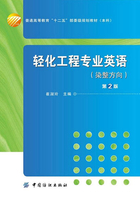
Exercises
1.Calculate the molar mass for each of the following.
(1)H2O
(2)H3PO4
(3)MgCl2
2.Fill in the blanks with the given words.
element,atom,electron,isotope,neutron,proton
All matter is composed of tiny,indivisible particles called________________,which are neither created nor destroyed in chemical reactions. An atom consists of a very dense central nucleus containing ________________and ________________,with________________moving about the nucleus at a relatively large distance from it. ________________are positively charged,________________have no charge,and________________ are negatively charged. Atoms of the same ________________ with the same number of protons but different numbers of neutrons are called as________________.
3.Translate the following sentence into English.
第一条也是最重要的原理是,化学物质是由分子组成的,分子中不同元素的原子是以一定的方式连接在一起的。
4.Translate the following into Chinese.
The basic postulates (n.假设,基本原理) of Dalton’s theory were as follows:
(1)Each element is composed of extremely small particles called atoms.
(2)All atoms of a given elements are identical.
(3)Atoms of different elements have different properties (including different masses).
(4)Atoms of an element are not changed into different types of atoms by chemical reactions. Atoms are neither created nor destroyed in chemical reactions.
(5)Compounds are formed when atoms of more than one element combine.
(6)In a given compound,the relative number and kind of atoms are constant.
References
[1] YODER J. DOE HDBK-1015/1-93,DOE Fundamentals Handbook: Chemistry [M]. Washington D.C.:U.S. Department of Energy,1993.
[2] BROWN T L. General chemistry [M]. 2nd ed. Ohio: Charles E. Merrill Publishing Company Columbus,1597.